Client-Centered Practices in Saudi Arabia: Application & History
VerifiedAdded on 2023/05/30
|17
|4689
|361
Essay
AI Summary
This essay explores the application of client-centered practices in Saudi Arabia's healthcare system, focusing on its history, key elements, and impact on patient care. Originating from Carl Rogers' humanistic ideologies, client-centered practice emphasizes partnership between healthcare providers and patients, empowering individuals to actively participate in their treatment plans. The essay highlights the importance of creating a therapeutic environment characterized by comfort, empathy, and genuineness. It also addresses the challenges and cultural considerations in implementing these practices in Saudi Arabia, particularly in managing chronic diseases like diabetes mellitus. The discussion includes the role of self-concept, trust-building, and addressing misconceptions to improve patient outcomes and overall healthcare experiences in the region. This resource is available on Desklib, where students can access a wealth of study materials and solved assignments.
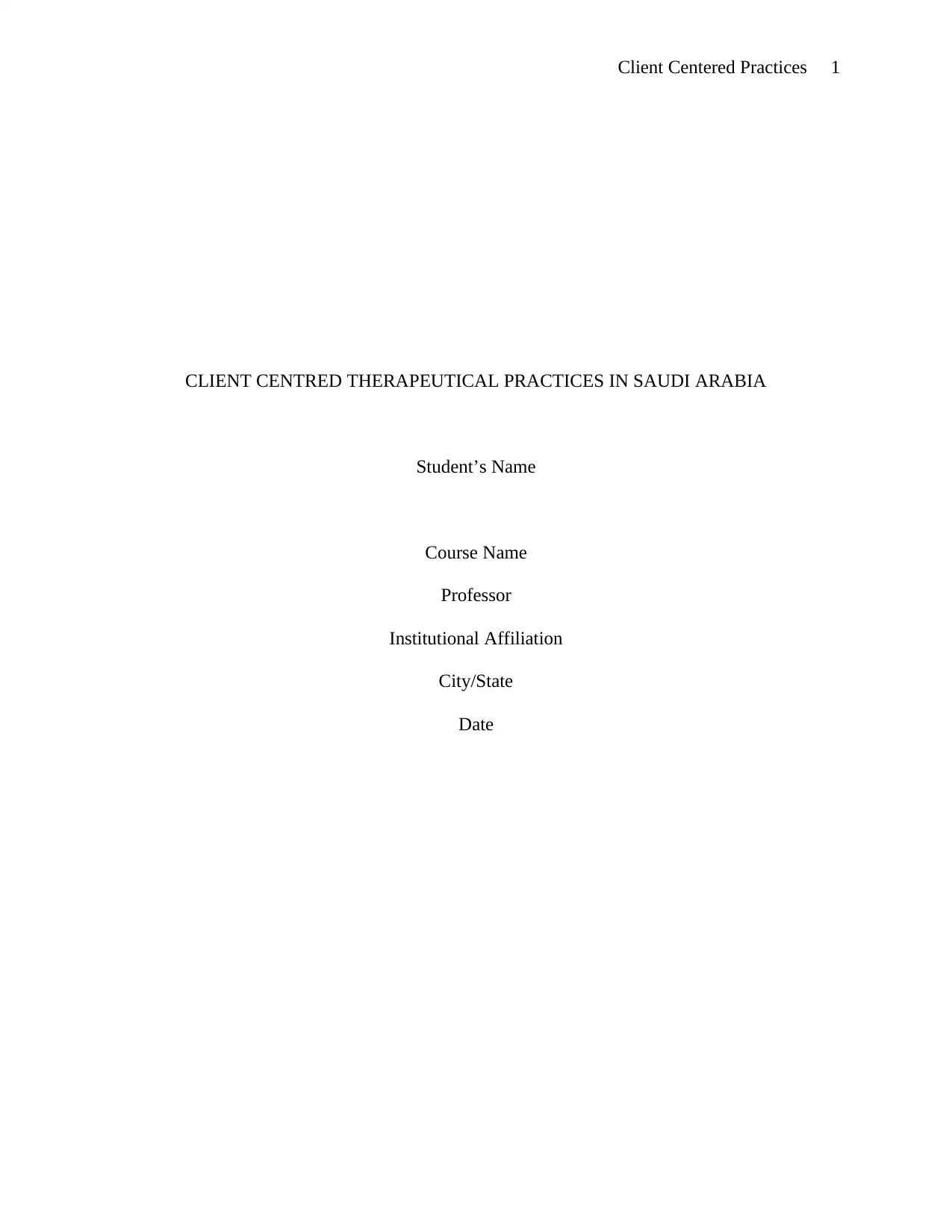
Client Centered Practices 1
CLIENT CENTRED THERAPEUTICAL PRACTICES IN SAUDI ARABIA
Student’s Name
Course Name
Professor
Institutional Affiliation
City/State
Date
CLIENT CENTRED THERAPEUTICAL PRACTICES IN SAUDI ARABIA
Student’s Name
Course Name
Professor
Institutional Affiliation
City/State
Date
Paraphrase This Document
Need a fresh take? Get an instant paraphrase of this document with our AI Paraphraser
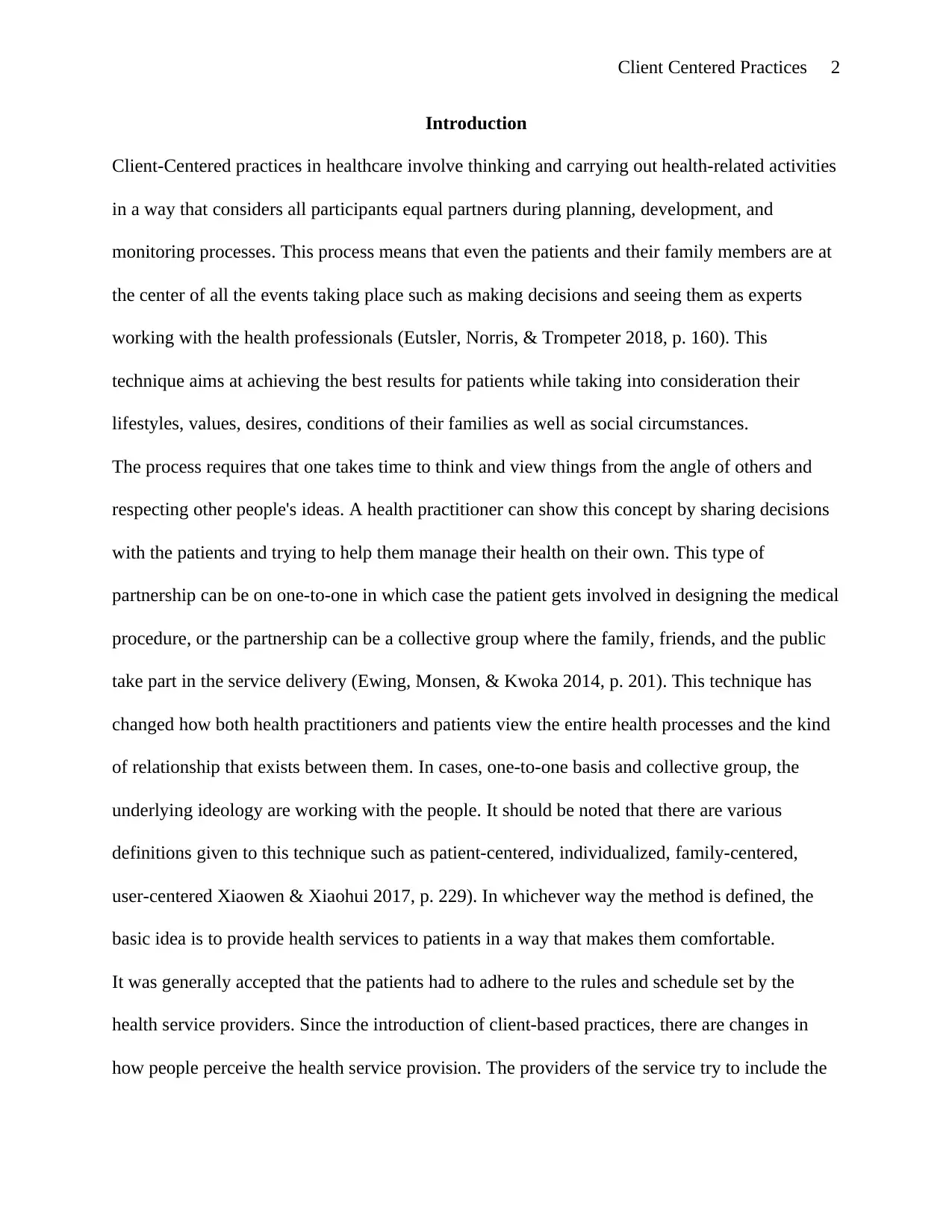
Client Centered Practices 2
Introduction
Client-Centered practices in healthcare involve thinking and carrying out health-related activities
in a way that considers all participants equal partners during planning, development, and
monitoring processes. This process means that even the patients and their family members are at
the center of all the events taking place such as making decisions and seeing them as experts
working with the health professionals (Eutsler, Norris, & Trompeter 2018, p. 160). This
technique aims at achieving the best results for patients while taking into consideration their
lifestyles, values, desires, conditions of their families as well as social circumstances.
The process requires that one takes time to think and view things from the angle of others and
respecting other people's ideas. A health practitioner can show this concept by sharing decisions
with the patients and trying to help them manage their health on their own. This type of
partnership can be on one-to-one in which case the patient gets involved in designing the medical
procedure, or the partnership can be a collective group where the family, friends, and the public
take part in the service delivery (Ewing, Monsen, & Kwoka 2014, p. 201). This technique has
changed how both health practitioners and patients view the entire health processes and the kind
of relationship that exists between them. In cases, one-to-one basis and collective group, the
underlying ideology are working with the people. It should be noted that there are various
definitions given to this technique such as patient-centered, individualized, family-centered,
user-centered Xiaowen & Xiaohui 2017, p. 229). In whichever way the method is defined, the
basic idea is to provide health services to patients in a way that makes them comfortable.
It was generally accepted that the patients had to adhere to the rules and schedule set by the
health service providers. Since the introduction of client-based practices, there are changes in
how people perceive the health service provision. The providers of the service try to include the
Introduction
Client-Centered practices in healthcare involve thinking and carrying out health-related activities
in a way that considers all participants equal partners during planning, development, and
monitoring processes. This process means that even the patients and their family members are at
the center of all the events taking place such as making decisions and seeing them as experts
working with the health professionals (Eutsler, Norris, & Trompeter 2018, p. 160). This
technique aims at achieving the best results for patients while taking into consideration their
lifestyles, values, desires, conditions of their families as well as social circumstances.
The process requires that one takes time to think and view things from the angle of others and
respecting other people's ideas. A health practitioner can show this concept by sharing decisions
with the patients and trying to help them manage their health on their own. This type of
partnership can be on one-to-one in which case the patient gets involved in designing the medical
procedure, or the partnership can be a collective group where the family, friends, and the public
take part in the service delivery (Ewing, Monsen, & Kwoka 2014, p. 201). This technique has
changed how both health practitioners and patients view the entire health processes and the kind
of relationship that exists between them. In cases, one-to-one basis and collective group, the
underlying ideology are working with the people. It should be noted that there are various
definitions given to this technique such as patient-centered, individualized, family-centered,
user-centered Xiaowen & Xiaohui 2017, p. 229). In whichever way the method is defined, the
basic idea is to provide health services to patients in a way that makes them comfortable.
It was generally accepted that the patients had to adhere to the rules and schedule set by the
health service providers. Since the introduction of client-based practices, there are changes in
how people perceive the health service provision. The providers of the service try to include the
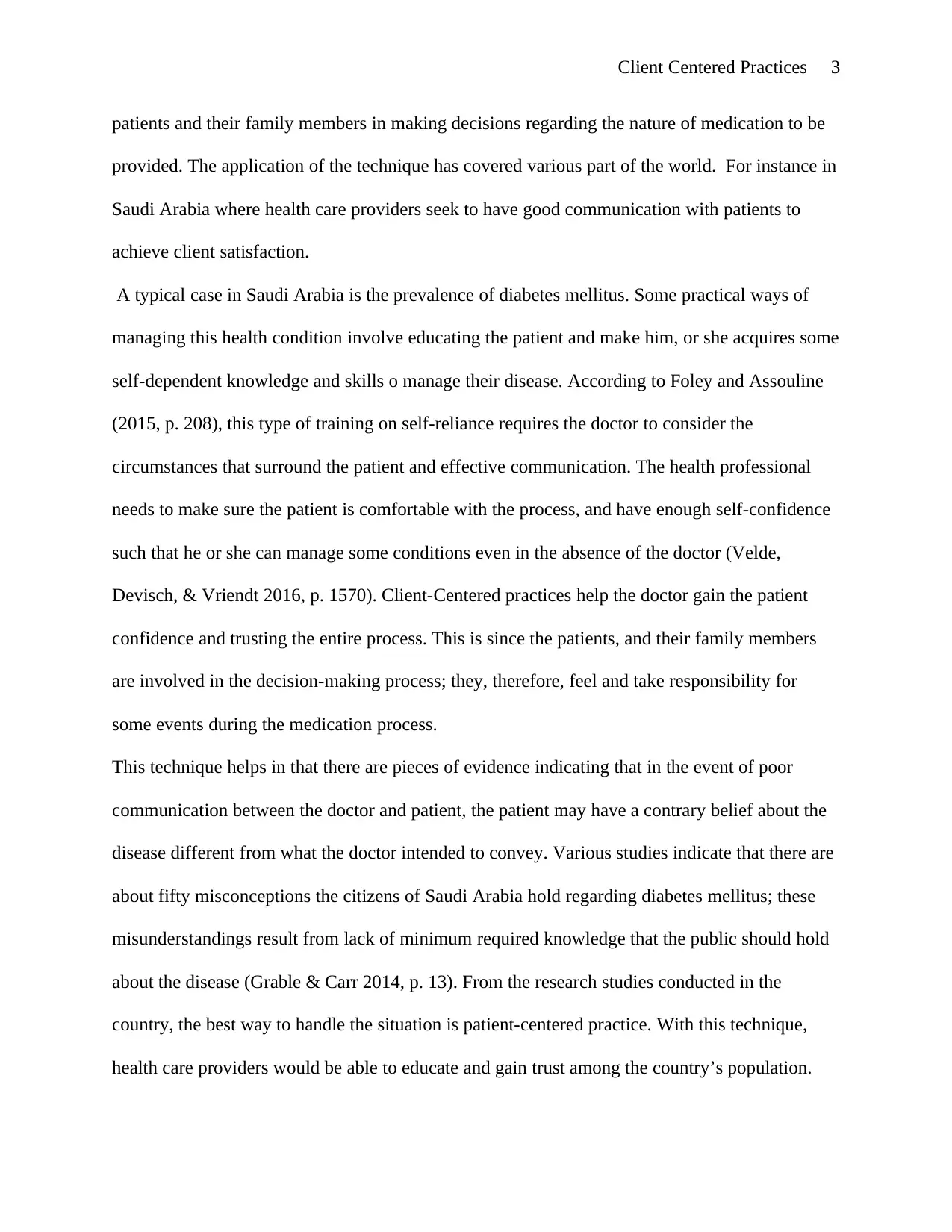
Client Centered Practices 3
patients and their family members in making decisions regarding the nature of medication to be
provided. The application of the technique has covered various part of the world. For instance in
Saudi Arabia where health care providers seek to have good communication with patients to
achieve client satisfaction.
A typical case in Saudi Arabia is the prevalence of diabetes mellitus. Some practical ways of
managing this health condition involve educating the patient and make him, or she acquires some
self-dependent knowledge and skills o manage their disease. According to Foley and Assouline
(2015, p. 208), this type of training on self-reliance requires the doctor to consider the
circumstances that surround the patient and effective communication. The health professional
needs to make sure the patient is comfortable with the process, and have enough self-confidence
such that he or she can manage some conditions even in the absence of the doctor (Velde,
Devisch, & Vriendt 2016, p. 1570). Client-Centered practices help the doctor gain the patient
confidence and trusting the entire process. This is since the patients, and their family members
are involved in the decision-making process; they, therefore, feel and take responsibility for
some events during the medication process.
This technique helps in that there are pieces of evidence indicating that in the event of poor
communication between the doctor and patient, the patient may have a contrary belief about the
disease different from what the doctor intended to convey. Various studies indicate that there are
about fifty misconceptions the citizens of Saudi Arabia hold regarding diabetes mellitus; these
misunderstandings result from lack of minimum required knowledge that the public should hold
about the disease (Grable & Carr 2014, p. 13). From the research studies conducted in the
country, the best way to handle the situation is patient-centered practice. With this technique,
health care providers would be able to educate and gain trust among the country’s population.
patients and their family members in making decisions regarding the nature of medication to be
provided. The application of the technique has covered various part of the world. For instance in
Saudi Arabia where health care providers seek to have good communication with patients to
achieve client satisfaction.
A typical case in Saudi Arabia is the prevalence of diabetes mellitus. Some practical ways of
managing this health condition involve educating the patient and make him, or she acquires some
self-dependent knowledge and skills o manage their disease. According to Foley and Assouline
(2015, p. 208), this type of training on self-reliance requires the doctor to consider the
circumstances that surround the patient and effective communication. The health professional
needs to make sure the patient is comfortable with the process, and have enough self-confidence
such that he or she can manage some conditions even in the absence of the doctor (Velde,
Devisch, & Vriendt 2016, p. 1570). Client-Centered practices help the doctor gain the patient
confidence and trusting the entire process. This is since the patients, and their family members
are involved in the decision-making process; they, therefore, feel and take responsibility for
some events during the medication process.
This technique helps in that there are pieces of evidence indicating that in the event of poor
communication between the doctor and patient, the patient may have a contrary belief about the
disease different from what the doctor intended to convey. Various studies indicate that there are
about fifty misconceptions the citizens of Saudi Arabia hold regarding diabetes mellitus; these
misunderstandings result from lack of minimum required knowledge that the public should hold
about the disease (Grable & Carr 2014, p. 13). From the research studies conducted in the
country, the best way to handle the situation is patient-centered practice. With this technique,
health care providers would be able to educate and gain trust among the country’s population.
⊘ This is a preview!⊘
Do you want full access?
Subscribe today to unlock all pages.

Trusted by 1+ million students worldwide
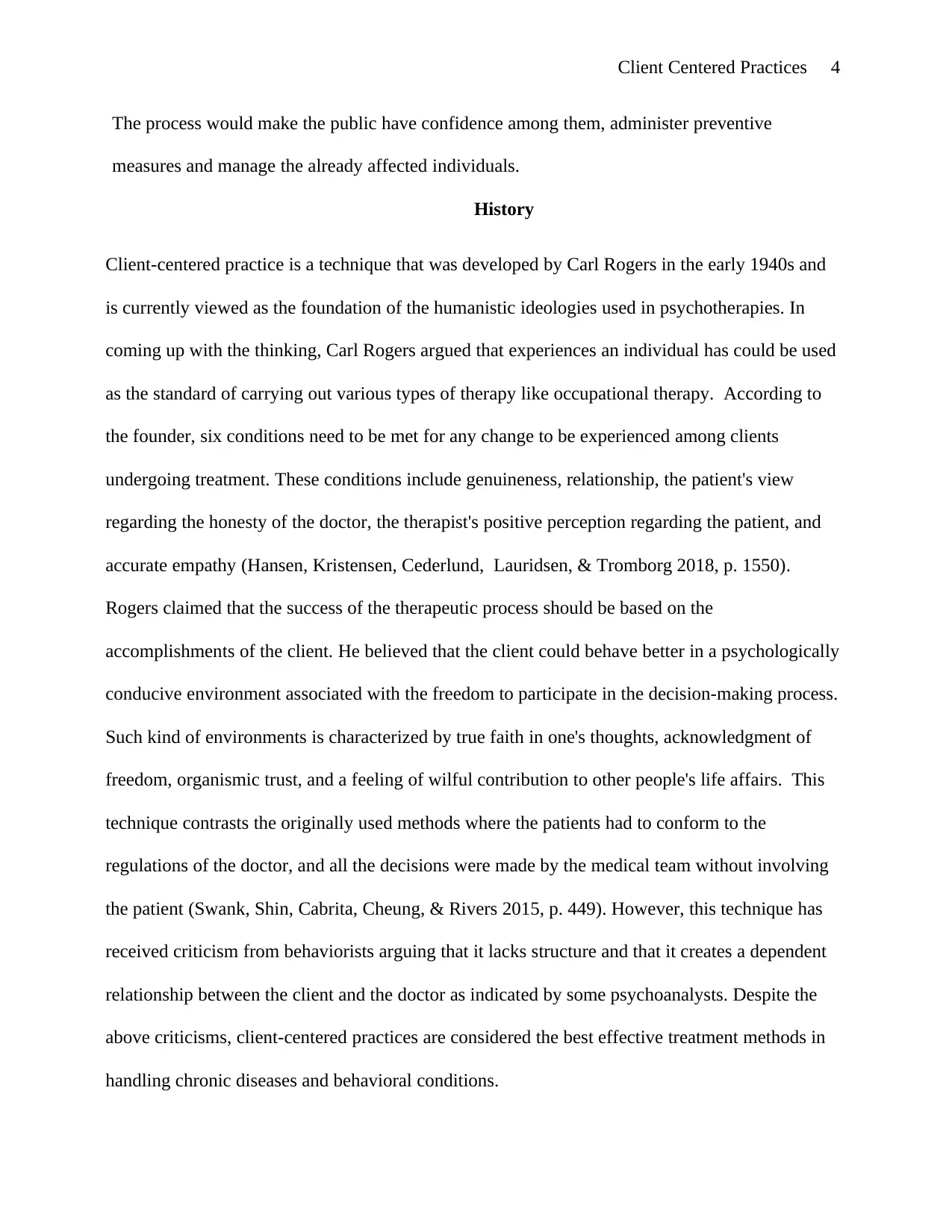
Client Centered Practices 4
The process would make the public have confidence among them, administer preventive
measures and manage the already affected individuals.
History
Client-centered practice is a technique that was developed by Carl Rogers in the early 1940s and
is currently viewed as the foundation of the humanistic ideologies used in psychotherapies. In
coming up with the thinking, Carl Rogers argued that experiences an individual has could be used
as the standard of carrying out various types of therapy like occupational therapy. According to
the founder, six conditions need to be met for any change to be experienced among clients
undergoing treatment. These conditions include genuineness, relationship, the patient's view
regarding the honesty of the doctor, the therapist's positive perception regarding the patient, and
accurate empathy (Hansen, Kristensen, Cederlund, Lauridsen, & Tromborg 2018, p. 1550).
Rogers claimed that the success of the therapeutic process should be based on the
accomplishments of the client. He believed that the client could behave better in a psychologically
conducive environment associated with the freedom to participate in the decision-making process.
Such kind of environments is characterized by true faith in one's thoughts, acknowledgment of
freedom, organismic trust, and a feeling of wilful contribution to other people's life affairs. This
technique contrasts the originally used methods where the patients had to conform to the
regulations of the doctor, and all the decisions were made by the medical team without involving
the patient (Swank, Shin, Cabrita, Cheung, & Rivers 2015, p. 449). However, this technique has
received criticism from behaviorists arguing that it lacks structure and that it creates a dependent
relationship between the client and the doctor as indicated by some psychoanalysts. Despite the
above criticisms, client-centered practices are considered the best effective treatment methods in
handling chronic diseases and behavioral conditions.
The process would make the public have confidence among them, administer preventive
measures and manage the already affected individuals.
History
Client-centered practice is a technique that was developed by Carl Rogers in the early 1940s and
is currently viewed as the foundation of the humanistic ideologies used in psychotherapies. In
coming up with the thinking, Carl Rogers argued that experiences an individual has could be used
as the standard of carrying out various types of therapy like occupational therapy. According to
the founder, six conditions need to be met for any change to be experienced among clients
undergoing treatment. These conditions include genuineness, relationship, the patient's view
regarding the honesty of the doctor, the therapist's positive perception regarding the patient, and
accurate empathy (Hansen, Kristensen, Cederlund, Lauridsen, & Tromborg 2018, p. 1550).
Rogers claimed that the success of the therapeutic process should be based on the
accomplishments of the client. He believed that the client could behave better in a psychologically
conducive environment associated with the freedom to participate in the decision-making process.
Such kind of environments is characterized by true faith in one's thoughts, acknowledgment of
freedom, organismic trust, and a feeling of wilful contribution to other people's life affairs. This
technique contrasts the originally used methods where the patients had to conform to the
regulations of the doctor, and all the decisions were made by the medical team without involving
the patient (Swank, Shin, Cabrita, Cheung, & Rivers 2015, p. 449). However, this technique has
received criticism from behaviorists arguing that it lacks structure and that it creates a dependent
relationship between the client and the doctor as indicated by some psychoanalysts. Despite the
above criticisms, client-centered practices are considered the best effective treatment methods in
handling chronic diseases and behavioral conditions.
Paraphrase This Document
Need a fresh take? Get an instant paraphrase of this document with our AI Paraphraser
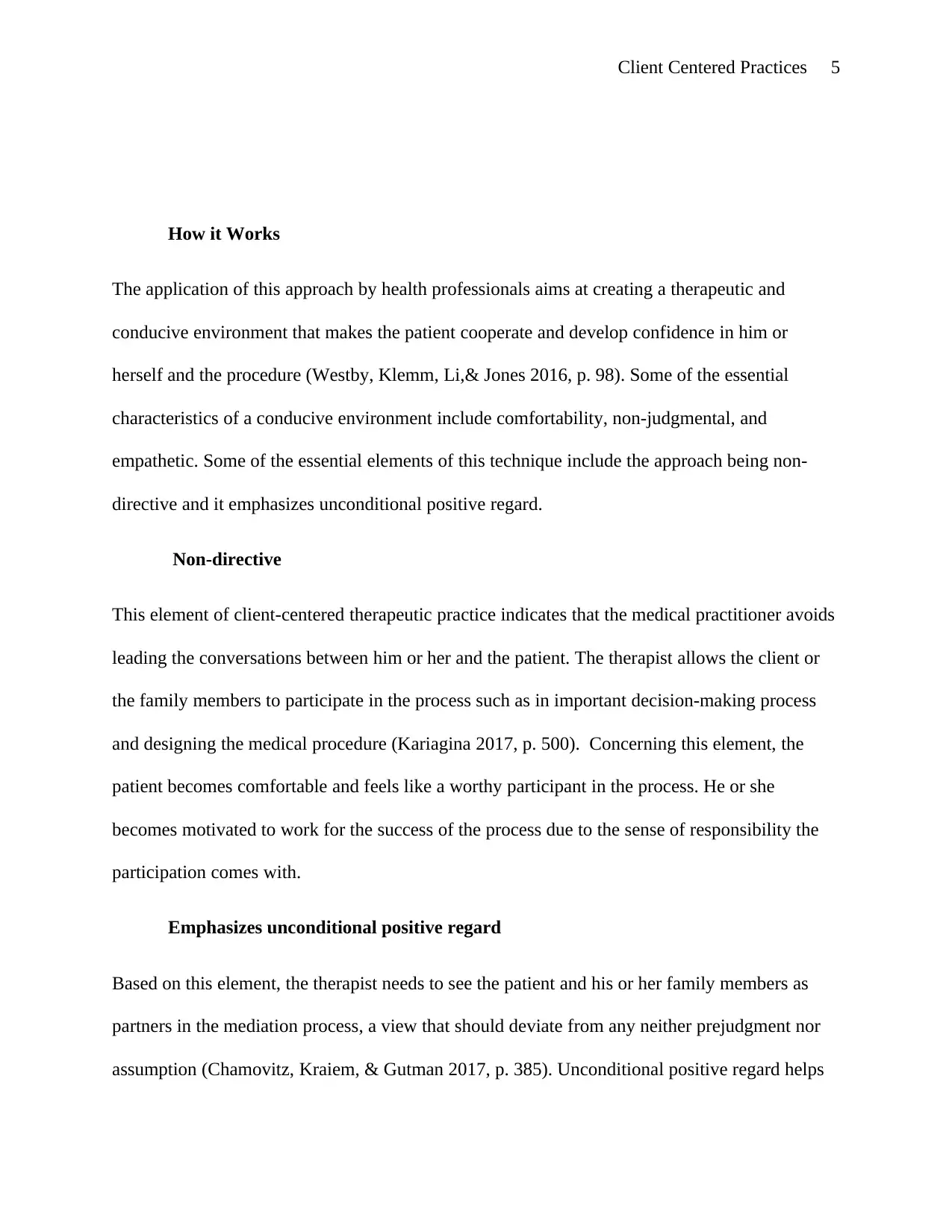
Client Centered Practices 5
How it Works
The application of this approach by health professionals aims at creating a therapeutic and
conducive environment that makes the patient cooperate and develop confidence in him or
herself and the procedure (Westby, Klemm, Li,& Jones 2016, p. 98). Some of the essential
characteristics of a conducive environment include comfortability, non-judgmental, and
empathetic. Some of the essential elements of this technique include the approach being non-
directive and it emphasizes unconditional positive regard.
Non-directive
This element of client-centered therapeutic practice indicates that the medical practitioner avoids
leading the conversations between him or her and the patient. The therapist allows the client or
the family members to participate in the process such as in important decision-making process
and designing the medical procedure (Kariagina 2017, p. 500). Concerning this element, the
patient becomes comfortable and feels like a worthy participant in the process. He or she
becomes motivated to work for the success of the process due to the sense of responsibility the
participation comes with.
Emphasizes unconditional positive regard
Based on this element, the therapist needs to see the patient and his or her family members as
partners in the mediation process, a view that should deviate from any neither prejudgment nor
assumption (Chamovitz, Kraiem, & Gutman 2017, p. 385). Unconditional positive regard helps
How it Works
The application of this approach by health professionals aims at creating a therapeutic and
conducive environment that makes the patient cooperate and develop confidence in him or
herself and the procedure (Westby, Klemm, Li,& Jones 2016, p. 98). Some of the essential
characteristics of a conducive environment include comfortability, non-judgmental, and
empathetic. Some of the essential elements of this technique include the approach being non-
directive and it emphasizes unconditional positive regard.
Non-directive
This element of client-centered therapeutic practice indicates that the medical practitioner avoids
leading the conversations between him or her and the patient. The therapist allows the client or
the family members to participate in the process such as in important decision-making process
and designing the medical procedure (Kariagina 2017, p. 500). Concerning this element, the
patient becomes comfortable and feels like a worthy participant in the process. He or she
becomes motivated to work for the success of the process due to the sense of responsibility the
participation comes with.
Emphasizes unconditional positive regard
Based on this element, the therapist needs to see the patient and his or her family members as
partners in the mediation process, a view that should deviate from any neither prejudgment nor
assumption (Chamovitz, Kraiem, & Gutman 2017, p. 385). Unconditional positive regard helps
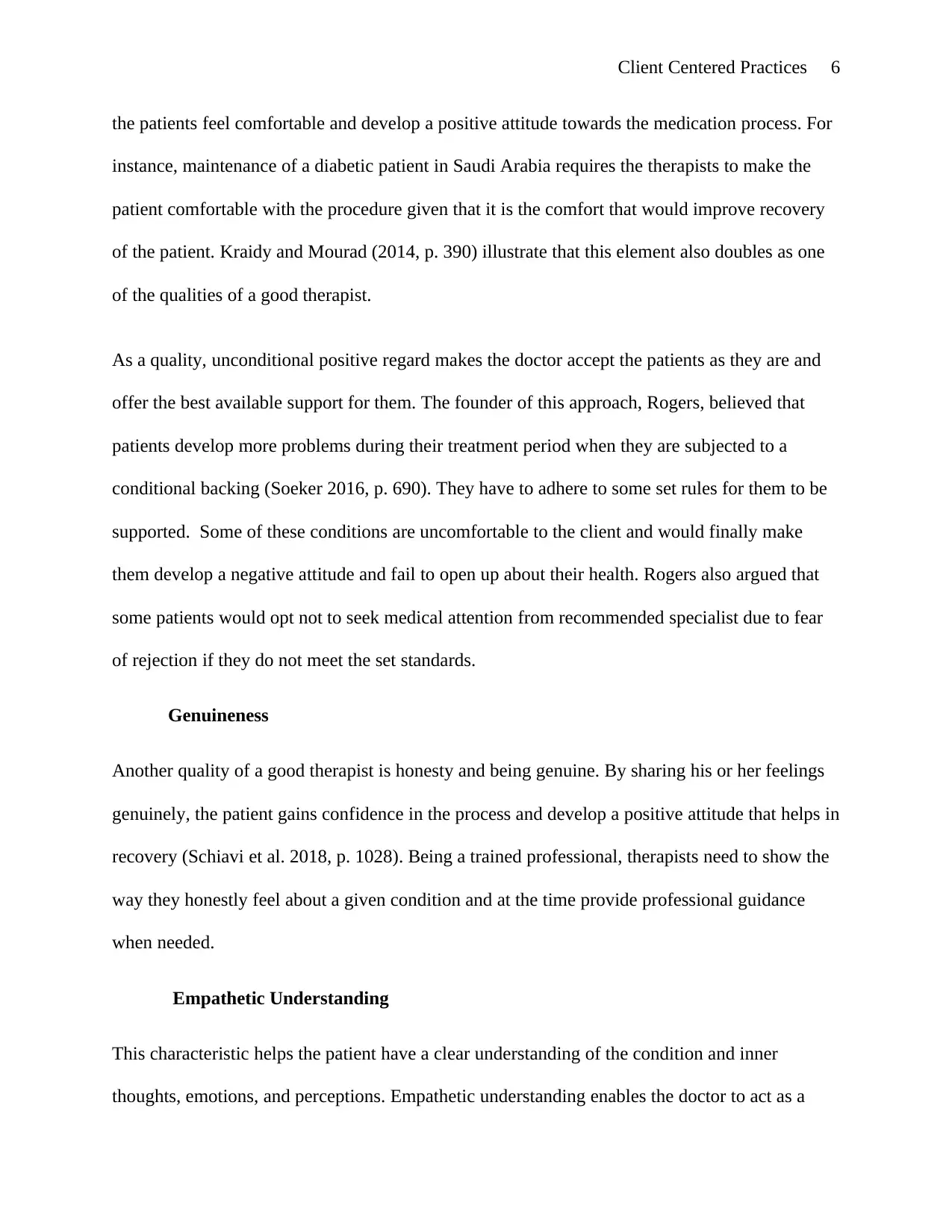
Client Centered Practices 6
the patients feel comfortable and develop a positive attitude towards the medication process. For
instance, maintenance of a diabetic patient in Saudi Arabia requires the therapists to make the
patient comfortable with the procedure given that it is the comfort that would improve recovery
of the patient. Kraidy and Mourad (2014, p. 390) illustrate that this element also doubles as one
of the qualities of a good therapist.
As a quality, unconditional positive regard makes the doctor accept the patients as they are and
offer the best available support for them. The founder of this approach, Rogers, believed that
patients develop more problems during their treatment period when they are subjected to a
conditional backing (Soeker 2016, p. 690). They have to adhere to some set rules for them to be
supported. Some of these conditions are uncomfortable to the client and would finally make
them develop a negative attitude and fail to open up about their health. Rogers also argued that
some patients would opt not to seek medical attention from recommended specialist due to fear
of rejection if they do not meet the set standards.
Genuineness
Another quality of a good therapist is honesty and being genuine. By sharing his or her feelings
genuinely, the patient gains confidence in the process and develop a positive attitude that helps in
recovery (Schiavi et al. 2018, p. 1028). Being a trained professional, therapists need to show the
way they honestly feel about a given condition and at the time provide professional guidance
when needed.
Empathetic Understanding
This characteristic helps the patient have a clear understanding of the condition and inner
thoughts, emotions, and perceptions. Empathetic understanding enables the doctor to act as a
the patients feel comfortable and develop a positive attitude towards the medication process. For
instance, maintenance of a diabetic patient in Saudi Arabia requires the therapists to make the
patient comfortable with the procedure given that it is the comfort that would improve recovery
of the patient. Kraidy and Mourad (2014, p. 390) illustrate that this element also doubles as one
of the qualities of a good therapist.
As a quality, unconditional positive regard makes the doctor accept the patients as they are and
offer the best available support for them. The founder of this approach, Rogers, believed that
patients develop more problems during their treatment period when they are subjected to a
conditional backing (Soeker 2016, p. 690). They have to adhere to some set rules for them to be
supported. Some of these conditions are uncomfortable to the client and would finally make
them develop a negative attitude and fail to open up about their health. Rogers also argued that
some patients would opt not to seek medical attention from recommended specialist due to fear
of rejection if they do not meet the set standards.
Genuineness
Another quality of a good therapist is honesty and being genuine. By sharing his or her feelings
genuinely, the patient gains confidence in the process and develop a positive attitude that helps in
recovery (Schiavi et al. 2018, p. 1028). Being a trained professional, therapists need to show the
way they honestly feel about a given condition and at the time provide professional guidance
when needed.
Empathetic Understanding
This characteristic helps the patient have a clear understanding of the condition and inner
thoughts, emotions, and perceptions. Empathetic understanding enables the doctor to act as a
⊘ This is a preview!⊘
Do you want full access?
Subscribe today to unlock all pages.

Trusted by 1+ million students worldwide
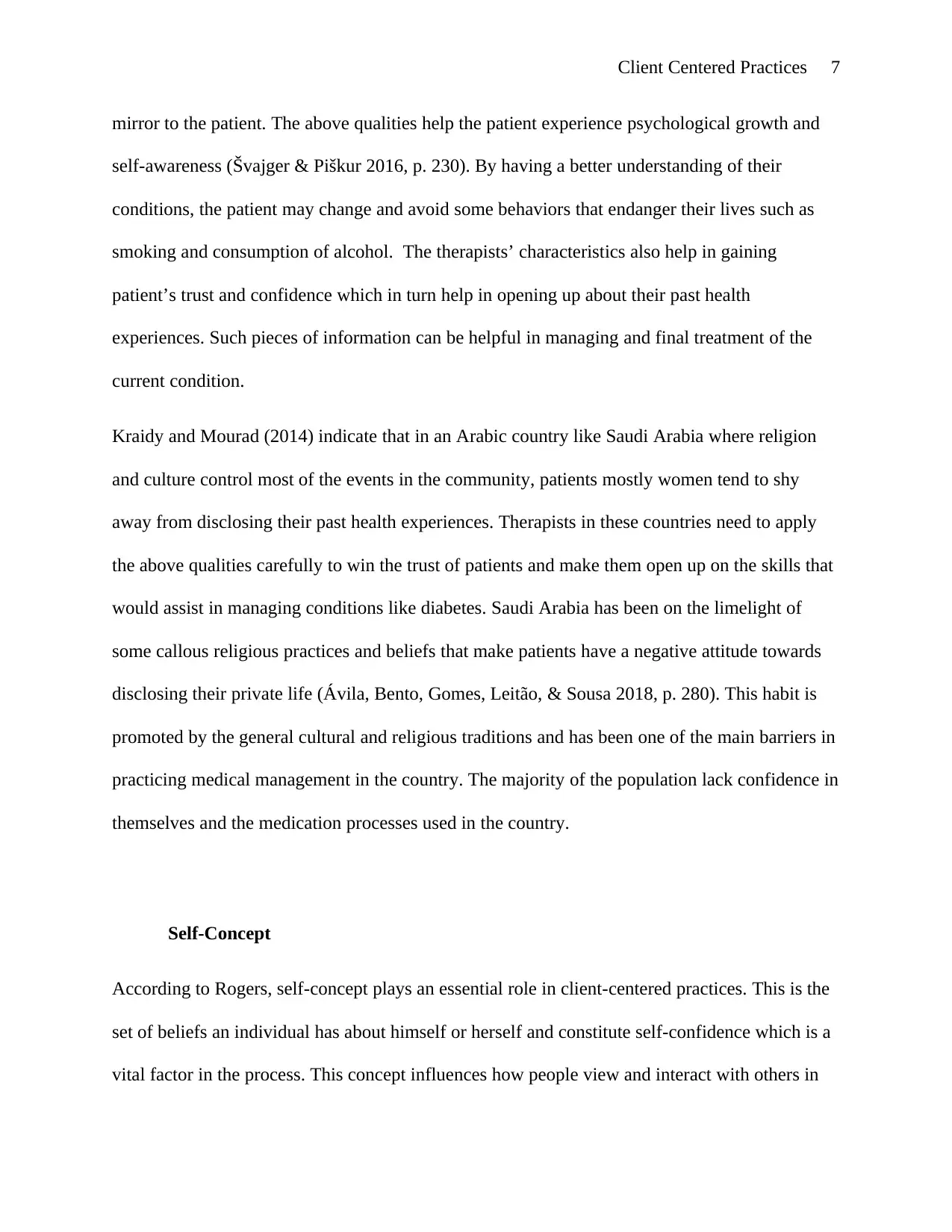
Client Centered Practices 7
mirror to the patient. The above qualities help the patient experience psychological growth and
self-awareness (Švajger & Piškur 2016, p. 230). By having a better understanding of their
conditions, the patient may change and avoid some behaviors that endanger their lives such as
smoking and consumption of alcohol. The therapists’ characteristics also help in gaining
patient’s trust and confidence which in turn help in opening up about their past health
experiences. Such pieces of information can be helpful in managing and final treatment of the
current condition.
Kraidy and Mourad (2014) indicate that in an Arabic country like Saudi Arabia where religion
and culture control most of the events in the community, patients mostly women tend to shy
away from disclosing their past health experiences. Therapists in these countries need to apply
the above qualities carefully to win the trust of patients and make them open up on the skills that
would assist in managing conditions like diabetes. Saudi Arabia has been on the limelight of
some callous religious practices and beliefs that make patients have a negative attitude towards
disclosing their private life (Ávila, Bento, Gomes, Leitão, & Sousa 2018, p. 280). This habit is
promoted by the general cultural and religious traditions and has been one of the main barriers in
practicing medical management in the country. The majority of the population lack confidence in
themselves and the medication processes used in the country.
Self-Concept
According to Rogers, self-concept plays an essential role in client-centered practices. This is the
set of beliefs an individual has about himself or herself and constitute self-confidence which is a
vital factor in the process. This concept influences how people view and interact with others in
mirror to the patient. The above qualities help the patient experience psychological growth and
self-awareness (Švajger & Piškur 2016, p. 230). By having a better understanding of their
conditions, the patient may change and avoid some behaviors that endanger their lives such as
smoking and consumption of alcohol. The therapists’ characteristics also help in gaining
patient’s trust and confidence which in turn help in opening up about their past health
experiences. Such pieces of information can be helpful in managing and final treatment of the
current condition.
Kraidy and Mourad (2014) indicate that in an Arabic country like Saudi Arabia where religion
and culture control most of the events in the community, patients mostly women tend to shy
away from disclosing their past health experiences. Therapists in these countries need to apply
the above qualities carefully to win the trust of patients and make them open up on the skills that
would assist in managing conditions like diabetes. Saudi Arabia has been on the limelight of
some callous religious practices and beliefs that make patients have a negative attitude towards
disclosing their private life (Ávila, Bento, Gomes, Leitão, & Sousa 2018, p. 280). This habit is
promoted by the general cultural and religious traditions and has been one of the main barriers in
practicing medical management in the country. The majority of the population lack confidence in
themselves and the medication processes used in the country.
Self-Concept
According to Rogers, self-concept plays an essential role in client-centered practices. This is the
set of beliefs an individual has about himself or herself and constitute self-confidence which is a
vital factor in the process. This concept influences how people view and interact with others in
Paraphrase This Document
Need a fresh take? Get an instant paraphrase of this document with our AI Paraphraser
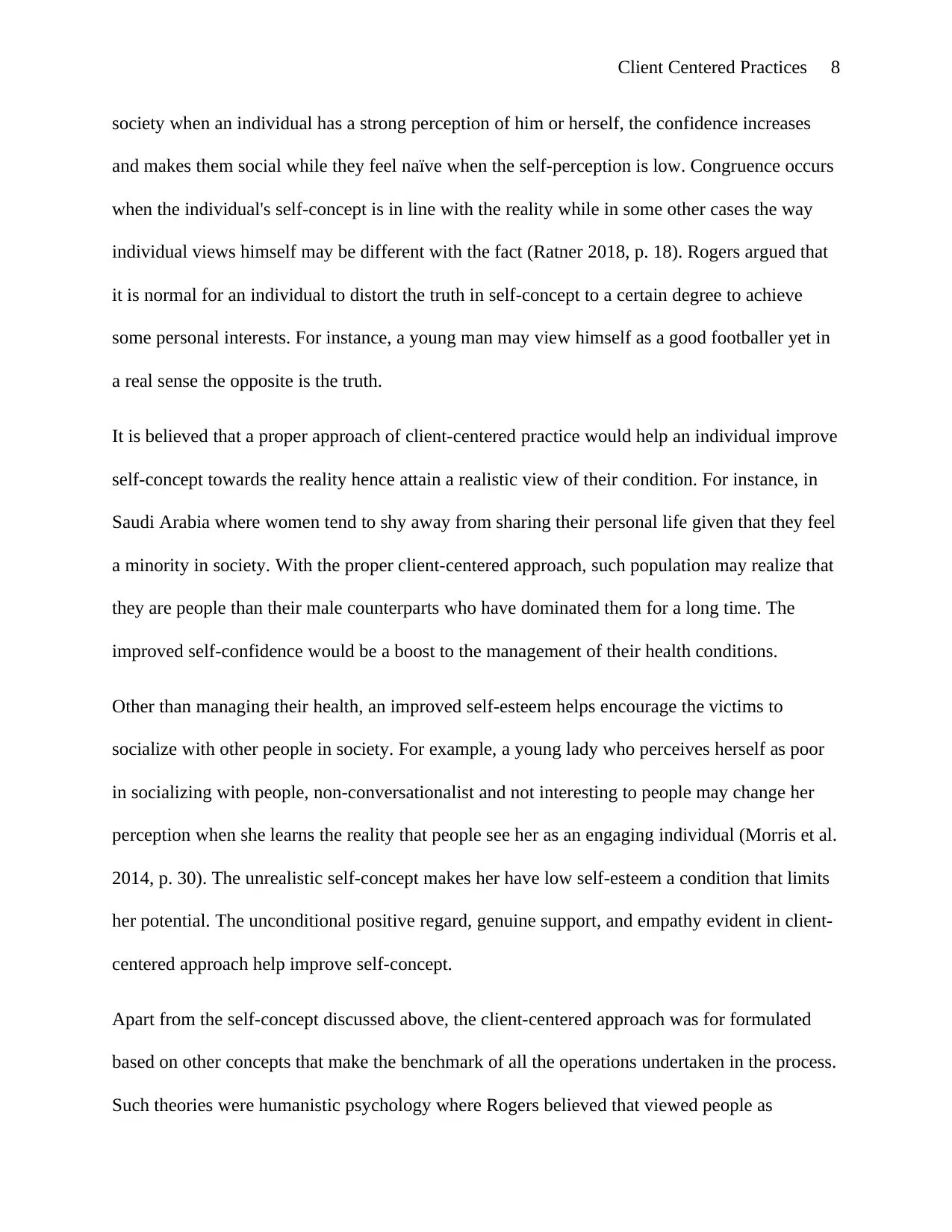
Client Centered Practices 8
society when an individual has a strong perception of him or herself, the confidence increases
and makes them social while they feel naïve when the self-perception is low. Congruence occurs
when the individual's self-concept is in line with the reality while in some other cases the way
individual views himself may be different with the fact (Ratner 2018, p. 18). Rogers argued that
it is normal for an individual to distort the truth in self-concept to a certain degree to achieve
some personal interests. For instance, a young man may view himself as a good footballer yet in
a real sense the opposite is the truth.
It is believed that a proper approach of client-centered practice would help an individual improve
self-concept towards the reality hence attain a realistic view of their condition. For instance, in
Saudi Arabia where women tend to shy away from sharing their personal life given that they feel
a minority in society. With the proper client-centered approach, such population may realize that
they are people than their male counterparts who have dominated them for a long time. The
improved self-confidence would be a boost to the management of their health conditions.
Other than managing their health, an improved self-esteem helps encourage the victims to
socialize with other people in society. For example, a young lady who perceives herself as poor
in socializing with people, non-conversationalist and not interesting to people may change her
perception when she learns the reality that people see her as an engaging individual (Morris et al.
2014, p. 30). The unrealistic self-concept makes her have low self-esteem a condition that limits
her potential. The unconditional positive regard, genuine support, and empathy evident in client-
centered approach help improve self-concept.
Apart from the self-concept discussed above, the client-centered approach was for formulated
based on other concepts that make the benchmark of all the operations undertaken in the process.
Such theories were humanistic psychology where Rogers believed that viewed people as
society when an individual has a strong perception of him or herself, the confidence increases
and makes them social while they feel naïve when the self-perception is low. Congruence occurs
when the individual's self-concept is in line with the reality while in some other cases the way
individual views himself may be different with the fact (Ratner 2018, p. 18). Rogers argued that
it is normal for an individual to distort the truth in self-concept to a certain degree to achieve
some personal interests. For instance, a young man may view himself as a good footballer yet in
a real sense the opposite is the truth.
It is believed that a proper approach of client-centered practice would help an individual improve
self-concept towards the reality hence attain a realistic view of their condition. For instance, in
Saudi Arabia where women tend to shy away from sharing their personal life given that they feel
a minority in society. With the proper client-centered approach, such population may realize that
they are people than their male counterparts who have dominated them for a long time. The
improved self-confidence would be a boost to the management of their health conditions.
Other than managing their health, an improved self-esteem helps encourage the victims to
socialize with other people in society. For example, a young lady who perceives herself as poor
in socializing with people, non-conversationalist and not interesting to people may change her
perception when she learns the reality that people see her as an engaging individual (Morris et al.
2014, p. 30). The unrealistic self-concept makes her have low self-esteem a condition that limits
her potential. The unconditional positive regard, genuine support, and empathy evident in client-
centered approach help improve self-concept.
Apart from the self-concept discussed above, the client-centered approach was for formulated
based on other concepts that make the benchmark of all the operations undertaken in the process.
Such theories were humanistic psychology where Rogers believed that viewed people as
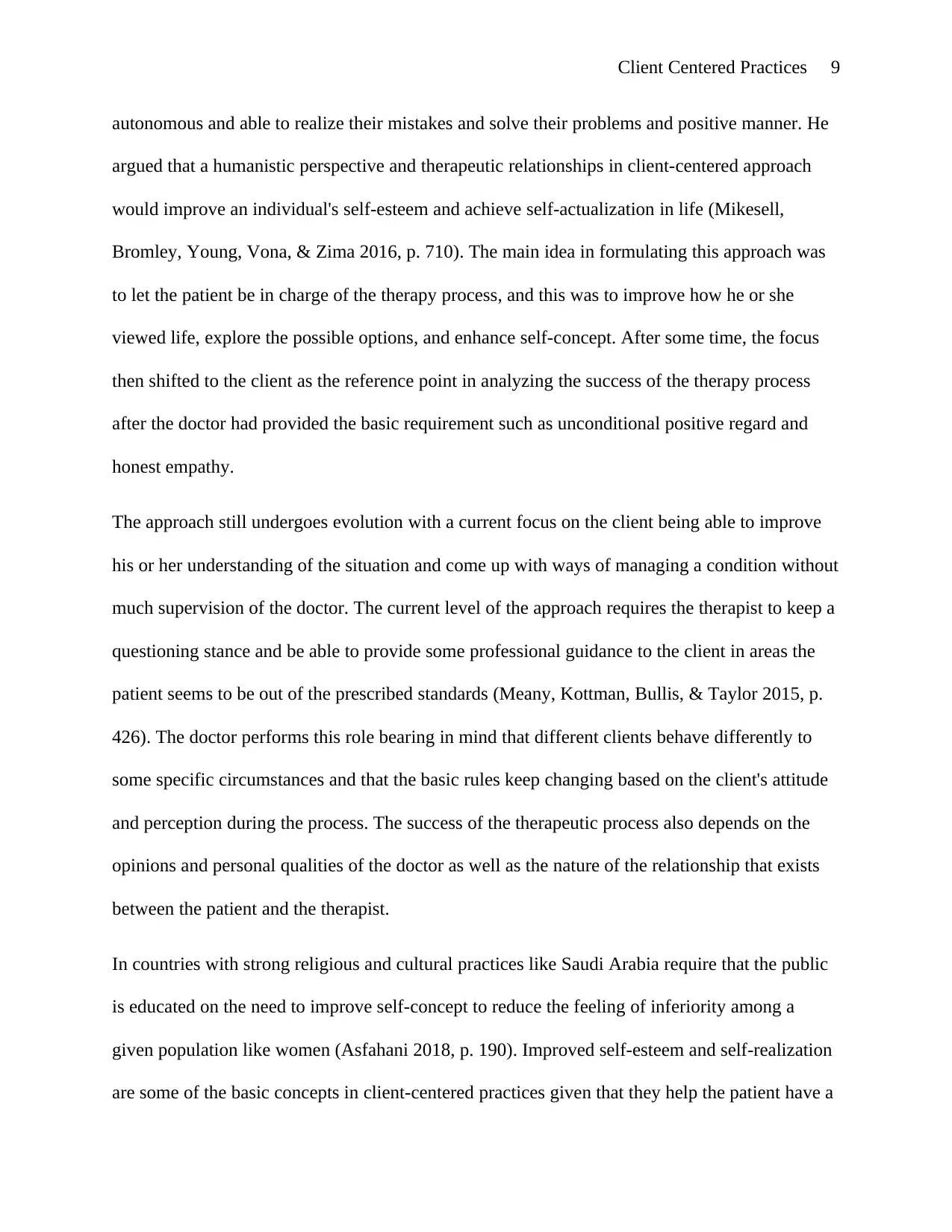
Client Centered Practices 9
autonomous and able to realize their mistakes and solve their problems and positive manner. He
argued that a humanistic perspective and therapeutic relationships in client-centered approach
would improve an individual's self-esteem and achieve self-actualization in life (Mikesell,
Bromley, Young, Vona, & Zima 2016, p. 710). The main idea in formulating this approach was
to let the patient be in charge of the therapy process, and this was to improve how he or she
viewed life, explore the possible options, and enhance self-concept. After some time, the focus
then shifted to the client as the reference point in analyzing the success of the therapy process
after the doctor had provided the basic requirement such as unconditional positive regard and
honest empathy.
The approach still undergoes evolution with a current focus on the client being able to improve
his or her understanding of the situation and come up with ways of managing a condition without
much supervision of the doctor. The current level of the approach requires the therapist to keep a
questioning stance and be able to provide some professional guidance to the client in areas the
patient seems to be out of the prescribed standards (Meany, Kottman, Bullis, & Taylor 2015, p.
426). The doctor performs this role bearing in mind that different clients behave differently to
some specific circumstances and that the basic rules keep changing based on the client's attitude
and perception during the process. The success of the therapeutic process also depends on the
opinions and personal qualities of the doctor as well as the nature of the relationship that exists
between the patient and the therapist.
In countries with strong religious and cultural practices like Saudi Arabia require that the public
is educated on the need to improve self-concept to reduce the feeling of inferiority among a
given population like women (Asfahani 2018, p. 190). Improved self-esteem and self-realization
are some of the basic concepts in client-centered practices given that they help the patient have a
autonomous and able to realize their mistakes and solve their problems and positive manner. He
argued that a humanistic perspective and therapeutic relationships in client-centered approach
would improve an individual's self-esteem and achieve self-actualization in life (Mikesell,
Bromley, Young, Vona, & Zima 2016, p. 710). The main idea in formulating this approach was
to let the patient be in charge of the therapy process, and this was to improve how he or she
viewed life, explore the possible options, and enhance self-concept. After some time, the focus
then shifted to the client as the reference point in analyzing the success of the therapy process
after the doctor had provided the basic requirement such as unconditional positive regard and
honest empathy.
The approach still undergoes evolution with a current focus on the client being able to improve
his or her understanding of the situation and come up with ways of managing a condition without
much supervision of the doctor. The current level of the approach requires the therapist to keep a
questioning stance and be able to provide some professional guidance to the client in areas the
patient seems to be out of the prescribed standards (Meany, Kottman, Bullis, & Taylor 2015, p.
426). The doctor performs this role bearing in mind that different clients behave differently to
some specific circumstances and that the basic rules keep changing based on the client's attitude
and perception during the process. The success of the therapeutic process also depends on the
opinions and personal qualities of the doctor as well as the nature of the relationship that exists
between the patient and the therapist.
In countries with strong religious and cultural practices like Saudi Arabia require that the public
is educated on the need to improve self-concept to reduce the feeling of inferiority among a
given population like women (Asfahani 2018, p. 190). Improved self-esteem and self-realization
are some of the basic concepts in client-centered practices given that they help the patient have a
⊘ This is a preview!⊘
Do you want full access?
Subscribe today to unlock all pages.

Trusted by 1+ million students worldwide
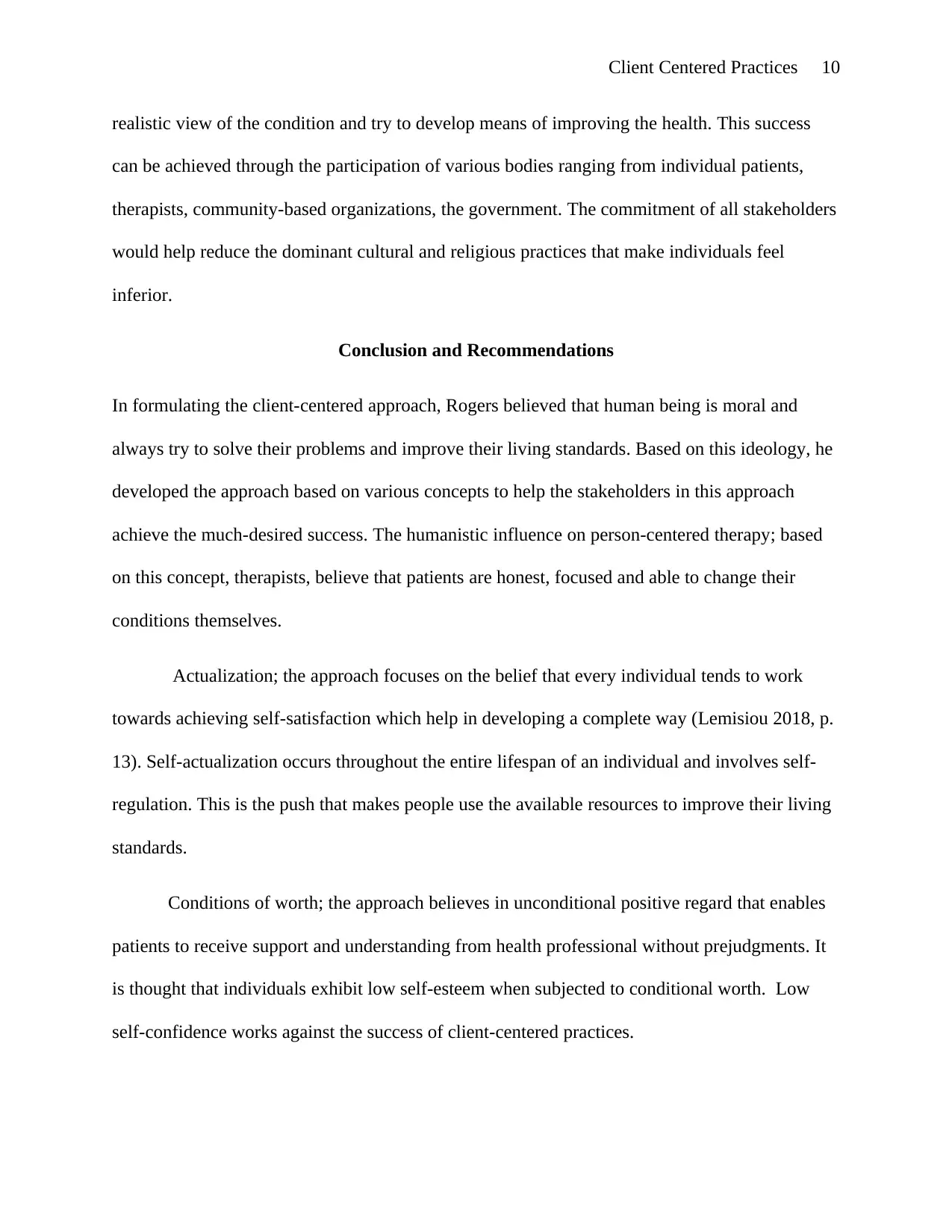
Client Centered Practices 10
realistic view of the condition and try to develop means of improving the health. This success
can be achieved through the participation of various bodies ranging from individual patients,
therapists, community-based organizations, the government. The commitment of all stakeholders
would help reduce the dominant cultural and religious practices that make individuals feel
inferior.
Conclusion and Recommendations
In formulating the client-centered approach, Rogers believed that human being is moral and
always try to solve their problems and improve their living standards. Based on this ideology, he
developed the approach based on various concepts to help the stakeholders in this approach
achieve the much-desired success. The humanistic influence on person-centered therapy; based
on this concept, therapists, believe that patients are honest, focused and able to change their
conditions themselves.
Actualization; the approach focuses on the belief that every individual tends to work
towards achieving self-satisfaction which help in developing a complete way (Lemisiou 2018, p.
13). Self-actualization occurs throughout the entire lifespan of an individual and involves self-
regulation. This is the push that makes people use the available resources to improve their living
standards.
Conditions of worth; the approach believes in unconditional positive regard that enables
patients to receive support and understanding from health professional without prejudgments. It
is thought that individuals exhibit low self-esteem when subjected to conditional worth. Low
self-confidence works against the success of client-centered practices.
realistic view of the condition and try to develop means of improving the health. This success
can be achieved through the participation of various bodies ranging from individual patients,
therapists, community-based organizations, the government. The commitment of all stakeholders
would help reduce the dominant cultural and religious practices that make individuals feel
inferior.
Conclusion and Recommendations
In formulating the client-centered approach, Rogers believed that human being is moral and
always try to solve their problems and improve their living standards. Based on this ideology, he
developed the approach based on various concepts to help the stakeholders in this approach
achieve the much-desired success. The humanistic influence on person-centered therapy; based
on this concept, therapists, believe that patients are honest, focused and able to change their
conditions themselves.
Actualization; the approach focuses on the belief that every individual tends to work
towards achieving self-satisfaction which help in developing a complete way (Lemisiou 2018, p.
13). Self-actualization occurs throughout the entire lifespan of an individual and involves self-
regulation. This is the push that makes people use the available resources to improve their living
standards.
Conditions of worth; the approach believes in unconditional positive regard that enables
patients to receive support and understanding from health professional without prejudgments. It
is thought that individuals exhibit low self-esteem when subjected to conditional worth. Low
self-confidence works against the success of client-centered practices.
Paraphrase This Document
Need a fresh take? Get an instant paraphrase of this document with our AI Paraphraser
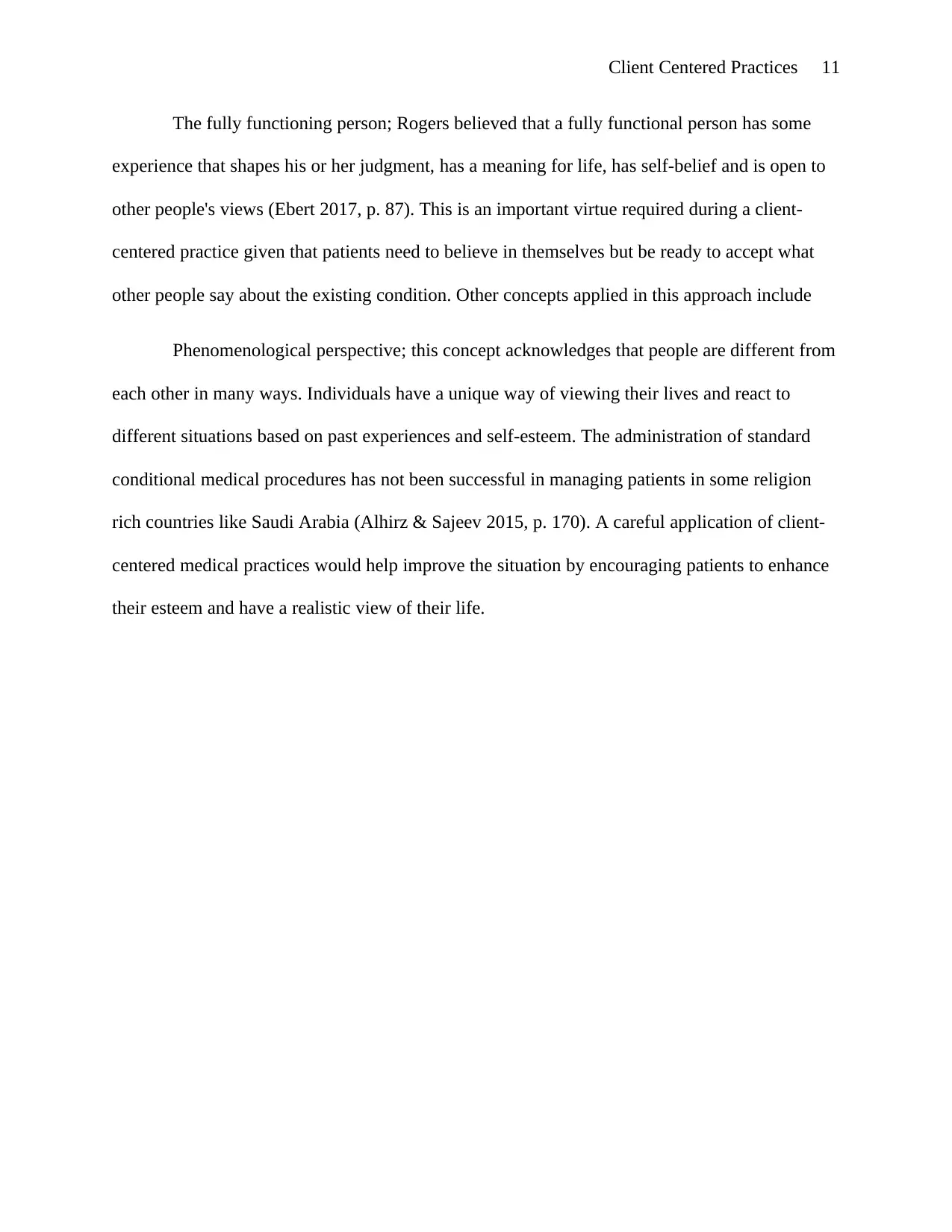
Client Centered Practices 11
The fully functioning person; Rogers believed that a fully functional person has some
experience that shapes his or her judgment, has a meaning for life, has self-belief and is open to
other people's views (Ebert 2017, p. 87). This is an important virtue required during a client-
centered practice given that patients need to believe in themselves but be ready to accept what
other people say about the existing condition. Other concepts applied in this approach include
Phenomenological perspective; this concept acknowledges that people are different from
each other in many ways. Individuals have a unique way of viewing their lives and react to
different situations based on past experiences and self-esteem. The administration of standard
conditional medical procedures has not been successful in managing patients in some religion
rich countries like Saudi Arabia (Alhirz & Sajeev 2015, p. 170). A careful application of client-
centered medical practices would help improve the situation by encouraging patients to enhance
their esteem and have a realistic view of their life.
The fully functioning person; Rogers believed that a fully functional person has some
experience that shapes his or her judgment, has a meaning for life, has self-belief and is open to
other people's views (Ebert 2017, p. 87). This is an important virtue required during a client-
centered practice given that patients need to believe in themselves but be ready to accept what
other people say about the existing condition. Other concepts applied in this approach include
Phenomenological perspective; this concept acknowledges that people are different from
each other in many ways. Individuals have a unique way of viewing their lives and react to
different situations based on past experiences and self-esteem. The administration of standard
conditional medical procedures has not been successful in managing patients in some religion
rich countries like Saudi Arabia (Alhirz & Sajeev 2015, p. 170). A careful application of client-
centered medical practices would help improve the situation by encouraging patients to enhance
their esteem and have a realistic view of their life.
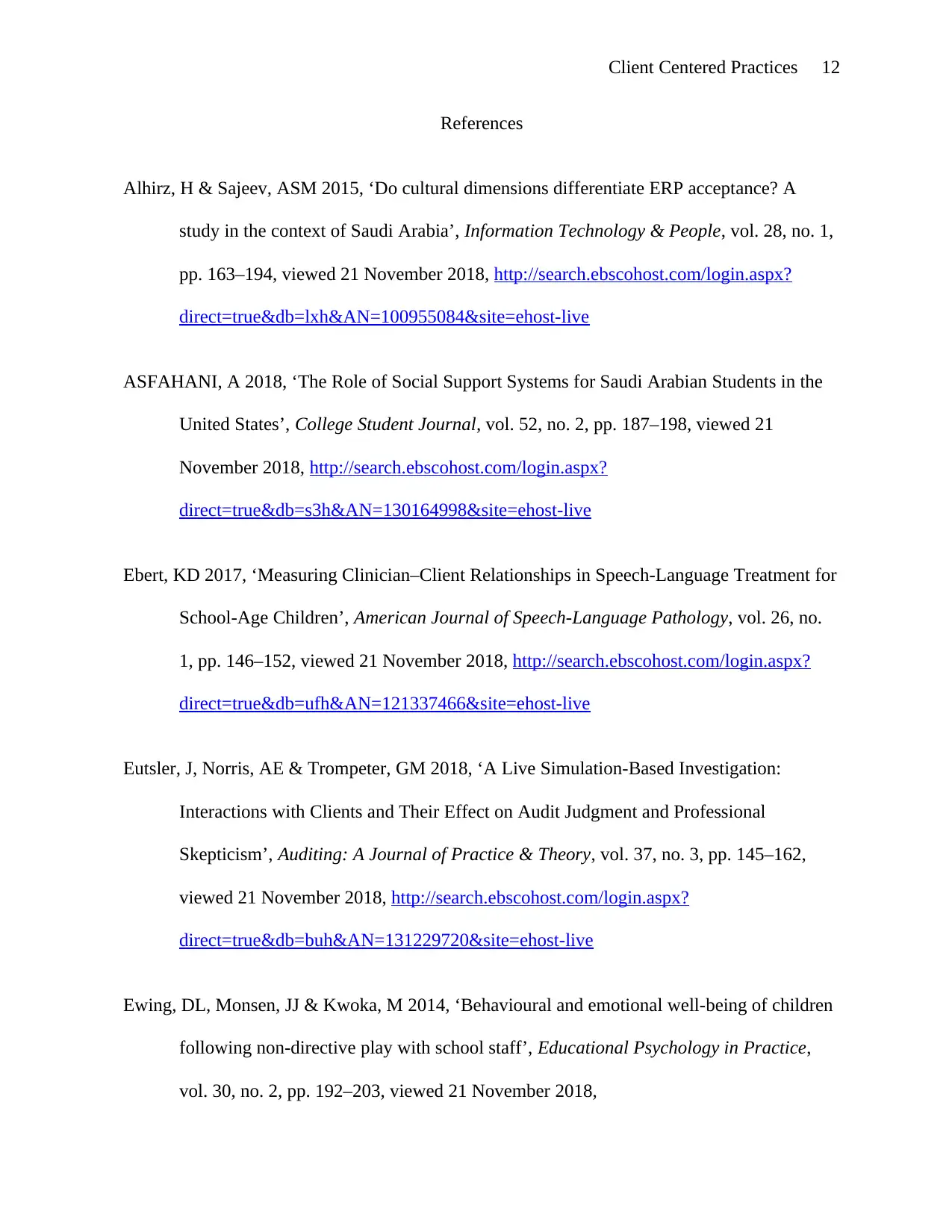
Client Centered Practices 12
References
Alhirz, H & Sajeev, ASM 2015, ‘Do cultural dimensions differentiate ERP acceptance? A
study in the context of Saudi Arabia’, Information Technology & People, vol. 28, no. 1,
pp. 163–194, viewed 21 November 2018, http://search.ebscohost.com/login.aspx?
direct=true&db=lxh&AN=100955084&site=ehost-live
ASFAHANI, A 2018, ‘The Role of Social Support Systems for Saudi Arabian Students in the
United States’, College Student Journal, vol. 52, no. 2, pp. 187–198, viewed 21
November 2018, http://search.ebscohost.com/login.aspx?
direct=true&db=s3h&AN=130164998&site=ehost-live
Ebert, KD 2017, ‘Measuring Clinician–Client Relationships in Speech-Language Treatment for
School-Age Children’, American Journal of Speech-Language Pathology, vol. 26, no.
1, pp. 146–152, viewed 21 November 2018, http://search.ebscohost.com/login.aspx?
direct=true&db=ufh&AN=121337466&site=ehost-live
Eutsler, J, Norris, AE & Trompeter, GM 2018, ‘A Live Simulation-Based Investigation:
Interactions with Clients and Their Effect on Audit Judgment and Professional
Skepticism’, Auditing: A Journal of Practice & Theory, vol. 37, no. 3, pp. 145–162,
viewed 21 November 2018, http://search.ebscohost.com/login.aspx?
direct=true&db=buh&AN=131229720&site=ehost-live
Ewing, DL, Monsen, JJ & Kwoka, M 2014, ‘Behavioural and emotional well-being of children
following non-directive play with school staff’, Educational Psychology in Practice,
vol. 30, no. 2, pp. 192–203, viewed 21 November 2018,
References
Alhirz, H & Sajeev, ASM 2015, ‘Do cultural dimensions differentiate ERP acceptance? A
study in the context of Saudi Arabia’, Information Technology & People, vol. 28, no. 1,
pp. 163–194, viewed 21 November 2018, http://search.ebscohost.com/login.aspx?
direct=true&db=lxh&AN=100955084&site=ehost-live
ASFAHANI, A 2018, ‘The Role of Social Support Systems for Saudi Arabian Students in the
United States’, College Student Journal, vol. 52, no. 2, pp. 187–198, viewed 21
November 2018, http://search.ebscohost.com/login.aspx?
direct=true&db=s3h&AN=130164998&site=ehost-live
Ebert, KD 2017, ‘Measuring Clinician–Client Relationships in Speech-Language Treatment for
School-Age Children’, American Journal of Speech-Language Pathology, vol. 26, no.
1, pp. 146–152, viewed 21 November 2018, http://search.ebscohost.com/login.aspx?
direct=true&db=ufh&AN=121337466&site=ehost-live
Eutsler, J, Norris, AE & Trompeter, GM 2018, ‘A Live Simulation-Based Investigation:
Interactions with Clients and Their Effect on Audit Judgment and Professional
Skepticism’, Auditing: A Journal of Practice & Theory, vol. 37, no. 3, pp. 145–162,
viewed 21 November 2018, http://search.ebscohost.com/login.aspx?
direct=true&db=buh&AN=131229720&site=ehost-live
Ewing, DL, Monsen, JJ & Kwoka, M 2014, ‘Behavioural and emotional well-being of children
following non-directive play with school staff’, Educational Psychology in Practice,
vol. 30, no. 2, pp. 192–203, viewed 21 November 2018,
⊘ This is a preview!⊘
Do you want full access?
Subscribe today to unlock all pages.

Trusted by 1+ million students worldwide
1 out of 17
Related Documents
Your All-in-One AI-Powered Toolkit for Academic Success.
+13062052269
info@desklib.com
Available 24*7 on WhatsApp / Email
![[object Object]](/_next/static/media/star-bottom.7253800d.svg)
Unlock your academic potential
Copyright © 2020–2025 A2Z Services. All Rights Reserved. Developed and managed by ZUCOL.





